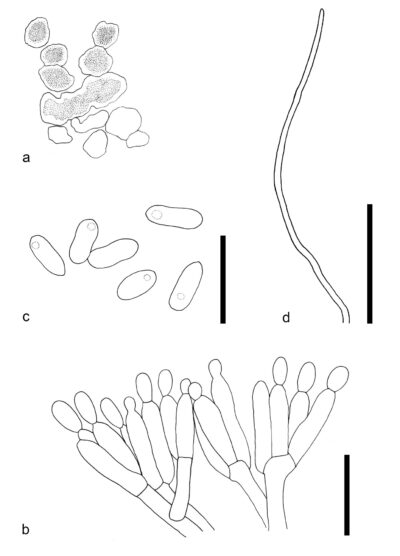Fungalpedia – Note 326, Tangerinosporium
Tangerinosporium L. Lombard & Crous
Citation when using this entry: Perera et al. 2024 (in prep.) – Fungalpedia, genera described in 2016.
Index Fungorum, Facesoffungi, MycoBank, GenBank, Fig. 1
Classification: Stachybotryaceae, Hypocreales, Hypocreomycetidae, Sordariomycetes, Pezizomycotina, Ascomycota, Fungi.
Lombard et al. (2016) established Tangerinosporium myrothecium-like taxon that formed a basal sister lineage to the Myrothecium s.str. clade in the analysis of cmdA, ITS, rpb2, and tub2. Tangerinosporium can be distinguished from other myrothecium-like genera by the production of orange conidial masses. This genus is characterized by sporodochial conidiomata that are stromatic, superficial, and scattered or gregarious on the substrate. They are pulvinate, oval, or irregular in outline, covered by an apricot to orange slimy or dry mass of conidia, and surrounded by a white setose-like fringe. Stroma are poorly developed, hyaline and angularis in texture. The setae are sparse, hyaline, thin-walled, unbranched, septate, straight to flexuous, and tapered to an acute apex. Tangerinosporium has penicillately branched, macronematous, hyaline conidiophores with smooth walls. They possess phialidic conidiogenous cells that are cylindrical to subcylindrical, straight to slightly curved, hyaline, smooth-walled, and conspicuous collarettes and periclinal thickening. The conidia are aseptate, hyaline, ellipsoidal to ossiform, and have a rounded basal end and visible apical hilum. The sexual morph remains undetermined (Lombard et al. 2016).
Type species: Tangerinosporium thalictricola L. Lombard & Crous
Other accepted species: This genus is monotypic.
Figure 1 – Tangerinosporium thalictricola (CBS 317.61, ex-type). a Sporodochia with conidial masses on colony surface. b Conidiogenous cells. c Conidia. d Seta. Scale bars: b, c = 10 μm, d = 20 μm. Redrawn from Lombard et al. (2016)
Reference
Entry by
Rekhani Hansika Perera, Center of Excellence in Fungal Research, Mae Fah Luang University, Chiang Rai, 57100, Thailand.
(Edited by Kevin D. Hyde, Samaneh Chaharmiri-Dokhaharani, & Achala R. Rathnayaka)
Published online 27 August 2024
